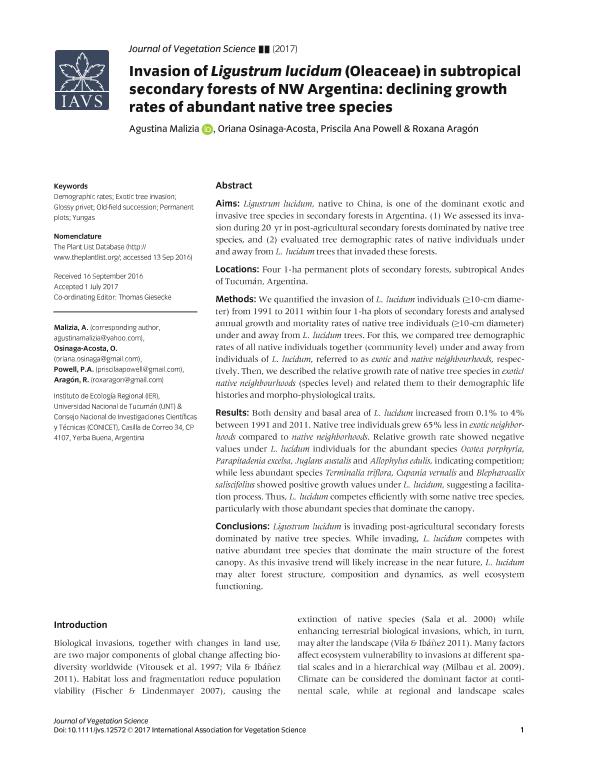Artículo
Invasion of Ligustrum lucidum (Oleaceae) in subtropical secondary forests of NW Argentina: declining growth rates of abundant native tree species
Fecha de publicación:
11/2017
Editorial:
Wiley Blackwell Publishing, Inc
Revista:
Journal of Vegetation Science
ISSN:
1100-9233
e-ISSN:
1654-1103
Idioma:
Inglés
Tipo de recurso:
Artículo publicado
Clasificación temática:
Resumen
Aims: Ligustrum lucidum, native to China, is one of the dominant exotic and invasive tree species in secondary forests in Argentina. (1) We assessed its invasion during 20 yr in post-agricultural secondary forests dominated by native tree species, and (2) evaluated tree demographic rates of native individuals under and away from L. lucidum trees that invaded these forests. Locations: Four 1-ha permanent plots of secondary forests, subtropical Andes of Tucumán, Argentina. Methods: We quantified the invasion of L. lucidum individuals (≥10-cm diameter) from 1991 to 2011 within four 1-ha plots of secondary forests and analysed annual growth and mortality rates of native tree individuals (≥10-cm diameter) under and away from L. lucidum trees. For this, we compared tree demographic rates of all native individuals together (community level) under and away from individuals of L. lucidum, referred to as exotic and native neighbourhoods, respectively. Then, we described the relative growth rate of native tree species in exotic/native neighbourhoods (species level) and related them to their demographic life histories and morpho-physiological traits. Results: Both density and basal area of L. lucidum increased from 0.1% to 4% between 1991 and 2011. Native tree individuals grew 65% less in exotic neighborhoods compared to native neighborhoods. Relative growth rate showed negative values under L. lucidum individuals for the abundant species Ocotea porphyria, Parapitadenia excelsa, Juglans austalis and Allophylus edulis, indicating competition; while less abundant species Terminalia triflora, Cupania vernalis and Blepharocalix saliscifolius showed positive growth values under L. lucidum, suggesting a facilitation process. Thus, L. lucidum competes efficiently with some native tree species, particularly with those abundant species that dominate the canopy. Conclusions: Ligustrum lucidum is invading post-agricultural secondary forests dominated by native tree species. While invading, L. lucidum competes with native abundant tree species that dominate the main structure of the forest canopy. As this invasive trend will likely increase in the near future, L. lucidum may alter forest structure, composition and dynamics, as well ecosystem functioning.
Archivos asociados
Licencia
Identificadores
Colecciones
Articulos(IER)
Articulos de INSTITUTO DE ECOLOGIA REGIONAL
Articulos de INSTITUTO DE ECOLOGIA REGIONAL
Citación
Malizia, Agustina; Osinaga Acosta, Oriana; Powell, Priscila Ana; Aragón, Myriam Roxana; Invasion of Ligustrum lucidum (Oleaceae) in subtropical secondary forests of NW Argentina: declining growth rates of abundant native tree species; Wiley Blackwell Publishing, Inc; Journal of Vegetation Science; 28; 6; 11-2017; 1240-1249
Compartir
Altmétricas




